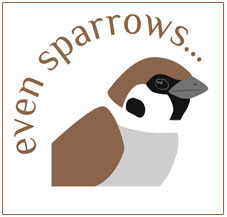

CONSIDER THE SPARROWS
Posted: 02.01.24 in Articles category
Seems familiar? It sounds like one of those phrases from the Gospels when Jesus told his followers to observe birds and reflect on God’s loving provision for them. He singled out certain birds that others would despise or ignore, and these included sparrows. However, his exhortation in the NIV translation to consider birds specifically referred to ravens. Read for yourself these words of Jesus in Luke 12 verse 24: “Consider the ravens: They do not sow or reap, they have no storeroom or barn; yet God feeds them.” Yet the title phrase seems apt. Jesus reminded people that our loving Father notices and provides for birds even as insignificant as sparrows.
Let’s consider sparrows. They currently number 28 species as members of the Old World true sparrow Passer genus, but these include neither bush sparrows nor American sparrows which belong to different families, albeit closely related. As a group, sparrows share several characteristics: they are relatively small and stocky, generally brown in plumage and have stout conical beaks which are ideal for crushing seeds, especially those of grasses and cereals. Sparrows are sociable; they roost communally, forage in flocks and nest colonially. They are also vocal, being quite noisy with a limited repertoire of chirrup and cheeping calls heard throughout much of the year. Moreover, sparrows are virtually sedentary – they don’t migrate and rarely stray from their natal area. They live near people, and indeed in much of their range it seems these birds cannot live without us!
The House Sparrow, is the most widespread species in the world today, being found in 6 continents including Australasia, southern Africa and both North and South America as birds introduced in the nineteenth and twentieth centuries. It is one of only two sparrow species found in the UK and was thought to be very common, but its numbers crashed towards the end of last century, especially in London and other large cities. The reasons for that collapse are not fully known. Various theories have been suggested: a resurgence in urban Sparrowhawks (which had been decimated by DDT poisoning); declining insect numbers, making it much more difficult for parent birds to feed their nestlings, and ironically the introduction of lead-free petrol in 1988 has perhaps been a factor too.
In her 2019 book on sparrows, Amy-Jane Beer quotes the finding of Max Nicholson who as a young birder in 1925 counted 2603 House Sparrows in a London park. Their numbers had fallen to 885 birds in that park by 1948, 544 birds in 1975, only 46 in 1995 and down to 8 birds in the year 2000 (which Nicholson personally witnessed at the age of 96!). Beer also records the catastrophic fall in the UK’s other sparrow species, the Tree Sparrow, whose numbers which fell by 93% between 1970 and 2006. I witnessed that decline where I live in Northumberland, which is why I chose the bird to be our Even Sparrows logo. Thankfully, the local Tree Sparrow population has slightly recovered, but numbers are still much too low and we may need to take action to save them. Amy-Jane Beer writes that “Saving House and Tree Sparrows is therefore a job for us all, and it starts with overcoming the ‘little brown job’ stereotype and noticing what is special. Noticing the black and the white and the maroon and the taupe among the brown. Noticing the restless movements and noisy chatter of a flock, the dusty ablutions, the lusty attempts to procreate, the effort of foraging and the bolshy bird-feeder antics. Noting these things now matters, because noticing them when the birds are truly scares may be too late.”
I am going to close my article with an extract from a poem by British Christian writer, Ann Lewin, in which she talks about noticing sparrows. Her poem, ‘Consider the birds’, is appropriately named, although she makes no mention of ravens. Yet sparrows are fully mentioned and wonderfully described as you can read below:
“…. Then there are sparrows,
So common we don’t notice them;
Eight a penny, or perhaps ten since decimalisation.
I wonder why you didn’t tell Job to look at sparrows,
Instead of parading the juggernauts of your creation.
After all, anyone could make a hippopotamus – no finesse there.
A lump with four legs and a great big head –
A child’s production.
But a sparrow, there’s craftmanship:
Those shades of brown and gold,
Arranged and sculpted into subtly beautiful plumage,
Each one different;
The stocky bodies full of energy,
Brisk, going about their business,
Fighting, squabbling,
Caring for their young,
Chirping in incessant cheerfulness….”